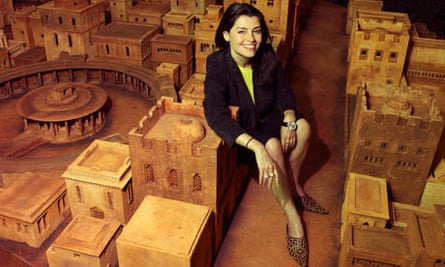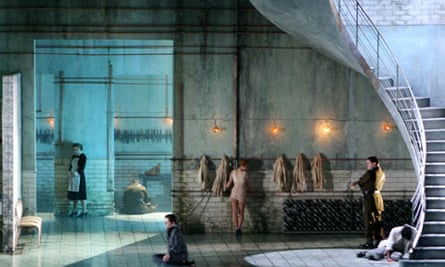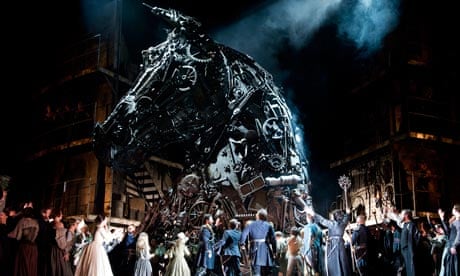What do Harold Pinter, Lady Gaga, the Royal Opera House, Batman and the organising committee of the London Olympic games have in common? More clues? Add to that list Kanye West, Sadlers Wells, Take That and the Royal Shakespeare Company. Answer: the stage designer Es Devlin. Since emerging in the late 1990s, Devlin has put together an impressively varied body of work that ranges from rooms above pubs, opera houses and sporting stadiums. A revival of her production of Strauss's Salome at the Royal Opera House has just closed and a new production of Berlioz's Les Troyens has just opened. She designed Kanye West's recent O2 concerts and Rihanna's sets for her Brits and Grammy appearances. In August she will design the closing ceremony for the London Olympic games.
"Of course they are all different, but they are also all the same in the thought processes that go into them," she explains. "There's no other way to do it." She says while the productions have different rhythms, with the lead time for opera measured in years and for television sometimes in hours, there is extensive cross-fertilisation of ideas that emerge over time. "I was thinking about a 20m-high man made out of junk for the Take That tour in 2010, at the same time as having my first thoughts about a huge horse made of destroyed weaponry for Les Troyens. I was creating a model of Gotham City for the Batman live show at the same time as a version of Bruges that was like a map of a brain, with its system of neural canals for Korngold's opera Die Tote Stadt in Helsinki. There's also a miniature city in Les Troyens. Everything comes out differently in the end, but you can sort of trace where my head has been at any given time."
Devlin has previously dealt with the narrative material of Berlioz's monumental five-hour opera based on the Aeneid when designing Euripides's Hecuba, starring Vanessa Redgrave, for the RSC. The research into Berlioz's life and work has largely come through David Cairns's award-winning biography. "The bloody thing is two volumes long. He could have got it into one book! But it is a magnificent project. Absolutely fascinating. And that's always the way it happens for me. Someone brings me a project I know little about before taking it on, and I find myself asking 'how the fuck didn't I know about this stuff?' It all adds to a bed of information that becomes part of my mental landscape that I then can't imagine not being there."
Les Troyens is directed by David McVicar. The pair also worked together on Salome and Devlin claims her route from theatre and opera into the pop world began with that production. In a South Bank Show about McVicar, Devlin was spotted by the pop singer Mika – "I suspect it was actually his mother who saw the programme, although he insists it was him" – which lead her to work on his stadium concerts. Soon after she was designing the Take That tour, working with some of the team behind the London 2012 events.
She chose Niall Ferguson's history of the British empire as her primary Olympics research book. "I was trying to find some virtuous things about the empire, but most of what I came across was pretty bad. However, British music was and is something we can be very proud of and so we have tried to imagine a celestial radio that only tunes into British music and then made something out of finding your way through the frequencies. There are a lot of technical restrictions – there is only a 4m door for a start, so nothing higher can be brought into the arena than that – so my starting point was simple: what would it be like with just a single voice in the darkness and we've gone from there."
And it was a simple sound and light show – albeit on a more modest scale than in an Olympic stadium – that provided Devlin with one of her first theatrical memories. "There was a son et lumière set in the model of Rye town where I lived as a child. The little houses would light up and they would tell the ghost stories associated with writers who had lived in the area such as Henry James, Rumer Godden and Joan Aiken. I loved it and actually took my own children back to see it quite recently; the magic held up pretty well."

Devlin was born in 1971 and grew up in Sussex. She and her siblings "made things all the time. We'd make board games and try to invent the new Monopoly. We'd always be playing round with projectors and light bulbs." Her theatrical exposure included annual pantos, but also trips to London with godparents to see Andrew Lloyd Webber shows. "I was stage struck, but that was as much to do with coming to London as with the shows. Woven into my memory of the shows was going to a restaurant and seeing the lights of cars going past the window. It was very exciting."
She played the violin, clarinet and piano and studied at the Royal Academy of Music Saturday classes but eventually went on to read English at university. A fine art foundation course followed at St Martin's before she was accepted to study set design on the Motley Theatre Design Course. "People kept telling me to go and look at this course which only has 10 people and is in Drury Lane. I wasn't even that much of a theatregoer – but that's not so unusual among designers. It's a standing joke that you ask what have they been to see lately and they haven't been to see anything – but when I got there I felt completely at home and that's when I started going to see absolutely everything in London as well as making things like a Duracell rabbit. I just got going."
In 1996 she won a Linbury award as a student "and the prize was a job, which is the best thing you can give anyone." She designed a production of Edward II in a swimming pool for the Bolton Octagon and by 1997 she was an associate artist at Bush Theatre from where she would "audaciously" send letters to theatre people asking them to see her shows. Trevor Nunn accepted the invitation – "he wanted to see the show anyway" – and in 1998 asked Devlin to design his new production of Pinter's Betrayal at the Lyttelton. Devlin wrote to Rachel Whiteread, explaining that she intended to pay homage to her art work, House, in her design for a play she thought was about remembered rooms.
"She gave her blessing which was wonderful. But that poor Pinter piece," Devlin laughs. "All it needed was a stage and some good acting. It's all in the writing and did not need all the stuff I laid on to it. But Pinter was so sweet about it and he would introduce me to people and say 'This is Es, she wrote the play.' I'd never do that design now, but I was thrilled that I did it then because it was absolutely what I believed in. It was wonderful that my parents gave us all so much confidence, and it's been a huge help. But when I look back now I do cringe a little. In that sense being given the name Esmeralda was a good as an open invitation to other children to prick that bubble at least a little bit, but some of the things I did were still so wrong, but I just pushed them through because of this confidence. People must have looked at me like I was crazy upstart, but I just muscled along."
It was an approach that soon saw her working with the Rambert Dance Company for the re-opening of Sadlers Wells and being asked to design her first opera for the Guildhall School of Drama. "And then things started to come in thick and fast," designing for the RSC as well as for opera houses all over europe. In 2003 she was offered her first non-operatic musical commission when the group Wire asked her to design one half – Jake and Dinos Chapman designed the other – of their farewell gig at the Barbican.
"I was becoming slightly institutionalised so it came at good time for me. When I began I would be asking theatres for awkward things and they would give me reasons why they couldn't do it. Pretty soon directors were asking me for awkward things and I would be telling them why they couldn't do it. I was getting a little conditioned by the establishment so to step outside theatre gave me a kind of jolt."
Kanye West heard about the Wire show and the two have been working together since 2005. "Seven years is quite something in a world that changes so rapidly. He's a completely extraordinary character. The speed of mind is phenomenal and you really have to be on your toes. You get halfway through a sentence and he says 'Yeah. got it.' And you have to move on. We've had some serious fights because he is a perfectionist. But you have to realise you are working with extraordinary people. I do think performers are a different species. It sounds pretentious, but if you have an opportunity to be part of what they're doing then you put your hands up and help out. I think I'm busy. But just getting up and being West or Gaga for a day is exhausting."

Devlin invited West to see Salome at Covent Garden and on his next tour he incorporated an orchestra pit into his stage show. She says there is increasing crossover between the different worlds in which she operates, particularly in terms of technology, but the essential aims are ultimately the same.
"It is all about creating a coherent world. If you walk into a theatre you trust your imagination to the people putting on the show. That is why it is so important at the beginning of a show to broker the terms of that engagement and then to see it through. It comes down to telling the truth. Honest people are interesting." The act of telling a truth is fascinating whether it's in a theatre, opera house or stadium. "You might think a Take That concert is lacking in truth. But when you are there, with 80,000 other people singing those tunes you see how important they have been to their lives. You hear those songs on the radio, whether by Gary Barlow or Elton John or whoever, and they hook into you before you realise what the song is. There is a huge emotional truth in that for an awful lot of people." One of her notes to self for the Olympics is that people have to get things absolutely instantly. "It has to be get it! Get it! Get it! You can pick out just a fraction of a song and people will recognise it immediately and it takes them to the place they remember it from. The music is going to be wonderful. Putting it on is the tricky bit."
After the last medal has been awarded Devlin and her team will have 16 hours to prepare the set. Half of that time will be spent protecting the pitch. "It's going to be tight. As Jay-Z says: 'Difficult takes a day, impossible takes a week,' which is part of the reason that when you work for these guys you can get a bit mangled. You are the person doing the impossible in a week. We will have rehearsals off-site and if we're lucky we'll get one inside on the day, but not necessarily. Flying? Lighting? Video? You'd usually say sort it all out in the tech rehearsal, but there might not be one. I don't normally get stressed, but I am a bit anxious about this one."

Comments (…)
Sign in or create your Guardian account to join the discussion